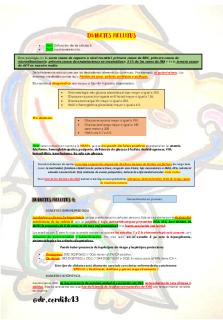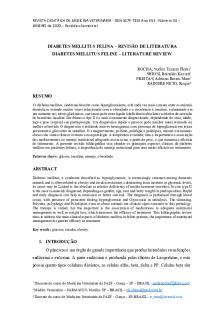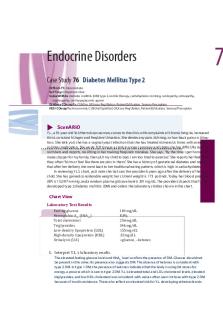Diabetes Mellitus Case Study v1 PDF

| Title | Diabetes Mellitus Case Study v1 |
|---|---|
| Author | Melissa Thomas |
| Course | Adult Nursing 1 |
| Institution | Pasco-Hernando State College |
| Pages | 3 |
| File Size | 60.9 KB |
| File Type | |
| Total Downloads | 10 |
| Total Views | 160 |
Summary
Diabetes case study...
Description
Diabetes Mellitus Case Study Total: 24 points (4 points) Discuss the pathophysiology of Type 1 Diabetes It is the destruction of the pancreatic beta cells. Type 1a is thought to be an autoimmune disease. Type 1b is does not have an immune response for beta cell destruction; strong link to a hereditary component. Beta cell destruction causes decreased insulin production and hyperglycemia. The liver does not store the sugar from eaten food and that allows the sugar to remain in the blood stream resulting in hyperglycemia. When there is too much sugar in the blood the kidneys cannot reabsorb the extra filtered glucose. This results in glycosuria. As the glucose leaves the body it is also pulling fluids and electrolytes with it – osmotic diuresis. Discuss the pathophysiology of Type II Diabetes This type is cause by insulin resistance and impaired insulin secretion. There is a decrease in tissue sensitivity to insulin. _______________________________________________________________________ (4 points) List s/s of hypoglycemia Blood glucose level is below 50 to 60 mg/dL Diaphoresis, tremor, tachycardia, palpitation, anxiety, hunger, inability to concentrate, headache, lightheadedness, confusion, memory lapses, numbness of the lips and tongue, slurred speech, impaired coordination, emotional changes, irrational or combative behavior, diplopia, drowsiness, disoriented behavior, difficulty arousing from sleep, seizures, loss of consciousness. List s/s of hyperglycemia Polyuria, polydipsia, polyphagia Dehydration, weight loss, fatigue and weakness, vision changes, dry skin, skin lesions, wounds that are slow to heal, recurrent infections, tingling or numbness or the hands and feet.
_________________________________________________________________
(4 points) List 5-10 complications of diabetes
1
Hypoglycemia, diabetic ketoacidosis, Hyperglycemic hyperosmolar nonketotic syndrome, macrovascular complications, microvascular complications, amputations, ulcers, diabetic neuropathy, peripheral artery disease,
A 55-year-old male client admitted to the healthcare facility complains of excessive thirst, urination, hunger, and numbness and tingling in the extremities. His fasting plasma glucose levels obtained on two different occasions are 136 mg/dL and 145 mg/dL. A diagnosis of type 2 diabetes is made. What data would the nurse need to gather before preparing a dietary plan for this client? (3 point) Calculate the client’s energy needs and caloric requirements What instructions should the nurse provide to the client regarding dietary restrictions? (3 point) In the book it mentions teaching the client to think about food in a different way rather than thinking of it being a new way of eating. Keep the information simple. Teach the client that they don’t have to give up certain things entirely but instead need to decrease their daily intake of that particular food.
The wife of a 48-year-old diabetic client, who was discharged from the healthcare facility a week ago, calls the telehealth service. She sounds worried and says her husband has been showing strange symptoms, such as confusion, nervousness, and excessive hunger, for the last 2 days. He has also been complaining of burred vision and dizziness. She tells the nurse that she had been administering insulin to her husband as directed by the physician but is not sure of the cause of his condition. What should the nurse tell the caller about the possible cause of these symptoms in the client? (3 point) It is possible that the client is in a hypoglycemic state. The client may have been receiving too much insulin thereby causing his sugar to drop too low. What possible measures should the nurse suggest the caller take to prevent further complications? (3 point) Make sure she is checking his blood sugar before giving him the insulin. Ask her to keep a record of blood glucose levels. Make sure to monitor the foods he is eating. Ask her about any changes in his diet regimen and exercise regimen. If
2
there has been a change to those things to be sure to let the doctor know so the proper adjustments can be made.
3...
Similar Free PDFs

Diabetes Mellitus Case Study v1
- 3 Pages

Diabetes Mellitus Case Study
- 15 Pages

Diabetes mellitus
- 15 Pages

Diabetes Mellitus
- 3 Pages

Diagnosis Diabetes Mellitus
- 4 Pages

Pathway of Diabetes Mellitus
- 4 Pages

makalah diabetes mellitus
- 10 Pages

DIABETES MELLITUS RESÚMEN CLAVE
- 3 Pages

PAE diabetes mellitus
- 16 Pages

Diabetes Mellitus em gatos
- 8 Pages

Ensayo diabetes mellitus
- 3 Pages
Popular Institutions
- Tinajero National High School - Annex
- Politeknik Caltex Riau
- Yokohama City University
- SGT University
- University of Al-Qadisiyah
- Divine Word College of Vigan
- Techniek College Rotterdam
- Universidade de Santiago
- Universiti Teknologi MARA Cawangan Johor Kampus Pasir Gudang
- Poltekkes Kemenkes Yogyakarta
- Baguio City National High School
- Colegio san marcos
- preparatoria uno
- Centro de Bachillerato Tecnológico Industrial y de Servicios No. 107
- Dalian Maritime University
- Quang Trung Secondary School
- Colegio Tecnológico en Informática
- Corporación Regional de Educación Superior
- Grupo CEDVA
- Dar Al Uloom University
- Centro de Estudios Preuniversitarios de la Universidad Nacional de Ingeniería
- 上智大学
- Aakash International School, Nuna Majara
- San Felipe Neri Catholic School
- Kang Chiao International School - New Taipei City
- Misamis Occidental National High School
- Institución Educativa Escuela Normal Juan Ladrilleros
- Kolehiyo ng Pantukan
- Batanes State College
- Instituto Continental
- Sekolah Menengah Kejuruan Kesehatan Kaltara (Tarakan)
- Colegio de La Inmaculada Concepcion - Cebu




